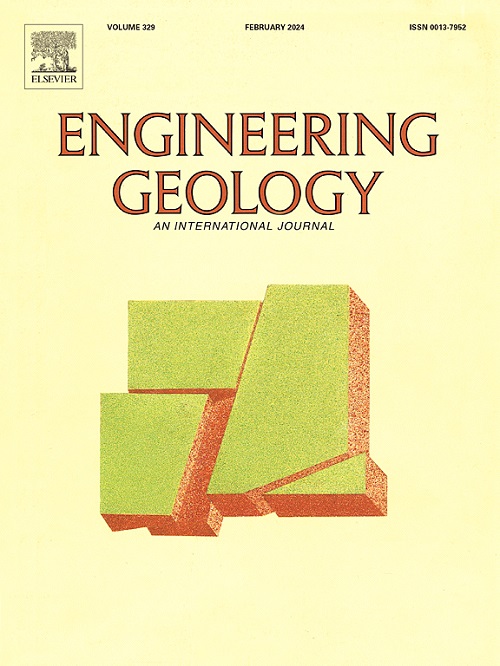含水合物沉积物中水合物解离过程中气液相流体运移的实验研究
IF 8.4
1区 工程技术
Q1 ENGINEERING, GEOLOGICAL
引用次数: 0
摘要
天然气水合物开采试验面临砂堵严重、气液分离差、地面沉降严重等问题。这是由于对水合物解离过程中复杂相变和气液多相流体运移的认识不足。在含水合物沉积体系中,水合物相变与气液流体运移相耦合。相变引起孔隙结构的变化,进而改变孔隙渗透参数和流体流动能力。同时,相界面的改变也会影响表面张力和润湿性等关键参数。气液流体迁移影响传热传质,从而影响相平衡和解离速率。为了弥补实验中描述水合物解离过程中气液流体运移的空白,本研究创新性地将非稳态水驱气与水合物定量解离过程相结合,自主开发了适合水合物解离的多相渗流实验系统,确定了不同孔隙度下渗流参数与水合物饱和度的关系。结果表明:a)初始孔隙度越高的岩心样品流体流动能力的恢复速率越高。b)多相流体的阻滞作用对湿相流体(水)的迁移影响比非湿相流体(甲烷)的迁移影响更显著。c)水合物解离过程中,绝对渗透率的演化呈“s”型,相对渗透率的演化呈“线束”型。研究结果可为地质灾害防治和水合物开采过程中的岩土工程设计提供理论依据。本文章由计算机程序翻译,如有差异,请以英文原文为准。
An experimental study on gas-liquid phase fluid migration in hydrate-bearing sediments during hydrate dissociation
Natural gas hydrate production tests face problems such as severe sand blockage, poor gas-liquid phase separation, and significant land subsidence. This is because of the insufficient understanding of the complex phase transition and gas-liquid multi-phase fluid migration during hydrate dissociation. In hydrate-bearing sediment systems, hydrate phase transition couples with gas-liquid fluid migration. The phase transition causes changes in pore structure, which in turn modifies porous infiltration parameters and fluid flow capacity. Meanwhile, alterations in phase interfaces affect key parameters like surface tension and wettability. Gas-liquid fluid migration influences heat and mass transfer, thus affecting phase equilibrium and dissociation rates. To bridge the gap in describing gas-liquid fluid migration during hydrate dissociation in experiments, this research innovatively integrated an unsteady-state gas displacement by water and a quantitative hydrate dissociation process, independently developed a multi-phase seepage experimental system suitable for hydrate dissociation and determined the relationship between seepage parameters and hydrate saturation under different porosity. The results are as follows: a) Core samples with higher initial porosity show a greater recovery rate of fluid flow capacity. b) The retarding effect of multi-phase fluid has a more significant impact on the migration of the wetting phase fluid (water) than that of the non-wetting phase fluid (methane). c) During hydrate dissociation, the evolution of absolute permeability shows an “S-shaped” pattern, and the evolution of relative permeability shows a “wiring-harness” pattern. The findings can provide a theoretical basis for preventing geological disasters and for geotechnical engineering design during hydrate production.
求助全文
通过发布文献求助,成功后即可免费获取论文全文。
去求助
来源期刊

Engineering Geology
地学-地球科学综合
CiteScore
13.70
自引率
12.20%
发文量
327
审稿时长
5.6 months
期刊介绍:
Engineering Geology, an international interdisciplinary journal, serves as a bridge between earth sciences and engineering, focusing on geological and geotechnical engineering. It welcomes studies with relevance to engineering, environmental concerns, and safety, catering to engineering geologists with backgrounds in geology or civil/mining engineering. Topics include applied geomorphology, structural geology, geophysics, geochemistry, environmental geology, hydrogeology, land use planning, natural hazards, remote sensing, soil and rock mechanics, and applied geotechnical engineering. The journal provides a platform for research at the intersection of geology and engineering disciplines.
 求助内容:
求助内容: 应助结果提醒方式:
应助结果提醒方式:


